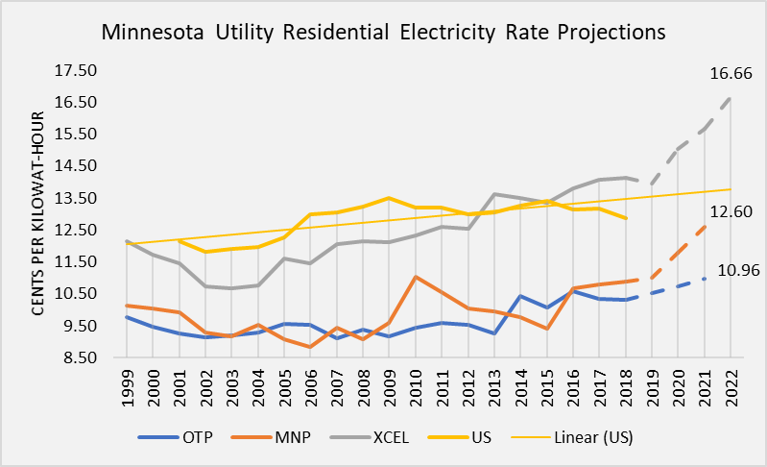Reactions to Proposed Rate Increases Shows Minnesota Citizen’s Utility Board Cares More about Renewables Than Ratepayers
The Minnesota Citizen’s Utility Board (CUB) claims to be the voice of ratepayers in the debates regarding Minnesota’s energy future. However, recent comments made by CUB regarding proposed electricity rate increases by Minnesota’s two largest investor owned utilities –Xcel Energy and Minnesota Power— suggest CUB cares more about promoting renewables than they care about protecting ratepayers.
Looking at the proposed rate increases, one would think that CUB would be far more upset about Xcel’s proposed 17.8 percent increase on residential customers than the 15 percent increase proposed by Minnesota Power, but you would be wrong.
When speaking of Xcel’s proposed price increase to the Star Tribune, CUB Executive Director Annie Levenson-Falk stated:
“Xcel’s proposed hike “is more than I expected,” said Annie Levenson-Falk, executive director of the Citizens Utility Board of Minnesota, an advocacy group for residential ratepayers. Still, she said it’s “pretty early to make a blanket judgment.”
“The return Xcel is asking for its shareholders is quite high, and we will definitely be looking at it,” Levenson-Falk said.”
Levenson-Falk was not nearly as open minded when speaking about Minnesota Power’s requested rate increase, according to another Star Tribune article:
“Annie Levenson-Falk, head of the advocacy group Citizens Utility Board of Minnesota, said the rate increase is meant to “shift electricity costs from large industry onto residential consumers.”
“As in past cases, Minnesota Power claims that residential customers are paying less for electricity than it costs to serve them, but expert witnesses in past rate cases have refuted similar arguments,” she said.
The difference in CUB’s treatment of Xcel and Minnesota Power is interesting considering residential customers served by Xcel Energy pay far more than those served by Minnesota Power. This discrepancy will only grow in the event that these price hikes are approved by the Minnesota Public Utilities Commission.
The graph below uses data from the U.S. Energy Information Administration to show electricity rates for each of Minnesota’s Investor Owned Utilities (IOU’s). As you can see, Xcel’s customers paid 23 percent more per kilowatt hour than Minnesota Power customers, and this will grow to 28 percent once the rate increases are finalized.

If CUB’s main priority is to ensure low costs for ratepayers, it makes no sense for the organization to be less critical of the larger rate increase, especially because Xcel’s rates are already far above the national average.
So why does CUB appear to favor Xcel over Minnesota Power? I believe the answer boils down to renewables.
CUB is an advocate for adding more renewable energy to the grid, and the Executive Director seems to believe it is possible to keep adding weather-dependent resources like wind and solar without driving up prices, but even Xcel Energy has admitted that renewables have driven up Minnesota electricity rates.
Xcel Energy wants to increase rates to cover $466 million in additional spending. The rate increase would allow the company to reap higher corporate profits, build wind turbines and transmission lines, make up for falling residential sales due to energy efficiency, and upgrade their nuclear power plants. This amount doesn’t even account for more than $1 billion for building wind turbines that will likely be in the next, even-larger rate increase.
For this, CUB says it is too early to make a blanket judgement.
In contrast, Minnesota Power is seeking to raise rates to generate $65 million in increased revenue to compensate for lost electricity sales to a paper company that permanently shuttered.
Minnesota Power is unique in that 74 percent of the electricity they sell goes to industrial customers. I am not aware of another utility in the country with this kind of customer profile. This means when a large industrial user shuts down, it has a big impact on the bottom line of all customers in the service territory, including residential customers.
The inverse is also true. When new industrial customers are added in the Minnesota Power service territory, residential customers benefit from having industrial customers buying more electricity. The proposed PolyMet mine could boost electricity consumption by nearly 5 percent, which would potentially help reduce rates for residential customers.
At the end of the day, there is no reason for CUB to be more upset about Minnesota Power’s rate increase than Xcel’s. I submit that the reason is that CUB cares about renewables first, and ratepayers second.
On the other hand, no organization in the state is a stauncher defender of ratepayers than Center of the American Experiment. Our organization is leading advocate for Minnesota families and businesses who can’t afford to keep paying higher costs for their electricity and I am encouraged that more people seem to understand this everyday.